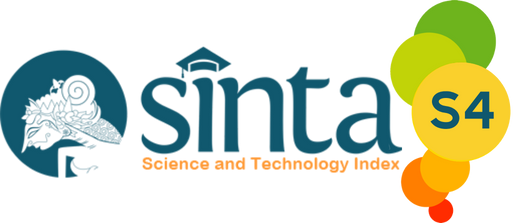Pemanfaatan Metode Simple Additive Weighting dalam Sistem Pendukung Keputusan untuk Menentukan Siswa Berprestasi
Abstract
⚠️Notice:
This article has been identified as a duplicate publication of the following article published in another journal:
Utilization Method Simple Additive Weighting in Decision Support Systems to Determine Outstanding Students
Media Informasi Teknologi (MIT)
(https://epublikasi.digitallinnovation.com/index.php/mit/article/view/189)
Based on internal verification, the authors did not request withdrawal and did not notify the JIPTEK Editorial Office that the manuscript had been submitted to another journal. This constitutes a violation of publication ethics, particularly regarding simultaneous submission and redundant publication, as outlined by the Committee on Publication Ethics (COPE) and JIPTEK’s editorial policy.
Accordingly, the Editorial Board declares this article as a duplicate publication. The article will remain available on the JIPTEK website to maintain the transparency and integrity of the scholarly record, accompanied by this official notice.
The Editorial Board of JIPTEK reaffirms its commitment to upholding academic integrity and strongly urges all authors to adhere to ethical publication standards at all stages of the submission and publication process.
Keywords
Full Text:
PDFReferences
Alyoubi, B. A. (2015). Decision Support System and Knowledge-based Strategic Management. Procedia Computer Science, 65(Iccmit), 278–284. https://doi.org/10.1016/j.procs.2015.09.079
Bangor, A., Staff, T., Kortum, P., Miller, J., & Staff, T. (2009). Determining what individual SUS scores mean: adding an adjective rating scale. Journal of Usability Studies, 4(3), 114–123.
Brooke, J. (2020a). SUS: A “Quick and Dirty” Usability Scale. Usability Evaluation In Industry, July, 207–212. https://doi.org/10.1201/9781498710411-35
Brooke, J. (2020b). SUS : A Retrospective. January 2013.
Effendy, F., & Nuqoba, B. (2016). Penerapan Framework Bootsrap Dalam Pembangunan Sistem Informasi Pengangkatan Dan Penjadwalan Pegawai (Studi Kasus:Rumah Sakit Bersalin Buah Delima Sidoarjo). Informatika Mulawarman : Jurnal Ilmiah Ilmu Komputer, 11(1), 9. https://doi.org/10.30872/jim.v11i1.197
H.N, I. A., Nugroho, P. I., & Ferdiana, R. (2015). Pengujian Usability Website Menggunakan System Usability Scale. JURNAL IPTEKKOM : Jurnal Ilmu Pengetahuan & Teknologi Informasi, 17(1), 31. https://doi.org/10.33164/iptekkom.17.1.2015.31-38
Hutasoit, R. S., Windarto, A. P., Hartama, D., & Solikhun, S. (2017). Sistem Pendukung Keputusan Pemilihan Guru Terbaik Pada Smk Maria Goretti Pematangsiantar Menggunakan Metode Simple Additive Weighting (Saw). Jurasik (Jurnal Riset Sistem Informasi Dan Teknik Informatika), 1(1), 56. https://doi.org/10.30645/jurasik.v1i1.9
Jumaryadi, Y. (2020). Implementation of Simple Additive Weighting Method for Best Performing Employee Selection (Case Study at National Standardization Agency of Indonesia). International Journal Of Information System And Computer Science (IJISCS), 4(2), 44–54.
Lewis Senior HF Engineer, J. R., & Sauro, J. (2017). Revisiting the Factor Structure of the System Usability Scale. Journal of Usability Studies, 12(4), 183–192.
Pojoh, S., Lantang, O. A., & Manembu, P. D. K. (2016). Sistem Pendukung Keputusan untuk Menentukan Siswa Berprestasi yang Layak Menjadi Siswa Teladan. Jurnal Teknik Informatika, 8(1). https://doi.org/10.35793/jti.8.1.2016.12823
Putra, A. S., Aryanti, D. R., & Hartati, I. (2018). Metode SAW (Simple Additive Weighting) sebagai Sistem Pendukung Keputusan Guru Berprestasi ( Studi Kasus : SMK Global Surya). Prosiding Seminar Nasional Darmajaya, 1(1), 85–97. https://jurnal.darmajaya.ac.id/index.php/PSND/article/view/1233/763
Setyani, R. E., & Saputra, R. (2016). Flood-prone Areas Mapping at Semarang City by Using Simple Additive Weighting Method. Procedia - Social and Behavioral Sciences, 227(November 2015), 378–386. https://doi.org/10.1016/j.sbspro.2016.06.089
Syah, M., Kesuma, A., & Gumilang, P. (2020). Pengujian Black Box pada Aplikasi Sistem Penunjang Keputusan Seleksi Calon Pegawai Negeri Sipil Menggunakan Teknik Equivalence Partitions. Jurnal Informatika Universitas Pamulang, 4(4), 131–136.
Wadisman, C., & Nozomi, I. (2019). Metode Couple Linear Congruential Generator (CLCG) untuk Ujian Sekolah Berbasis Web. INTECOMS: Journal of Information Technology and Computer Science, 2(2), 91–99. https://doi.org/10.31539/intecoms.v2i2.939
Wang, P., Zhu, Z., & Wang, Y. (2016). A novel hybrid MCDM model combining the SAW, TOPSIS and GRA methods based on experimental design. Information Sciences, 345, 27–45. https://doi.org/10.1016/j.ins.2016.01.076
Widiastuti, Y., Sihwi, S. W., & Sulistyo, M. E. (2016). Decision Support System for House Purchasing Using Knn ( K-Nearest Neighbor ) Method. Jurnal Itsmart, 5(1), 43–49.
Refbacks
- There are currently no refbacks.







